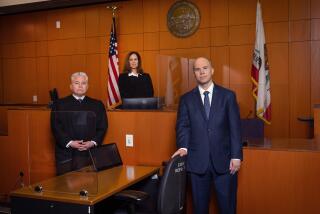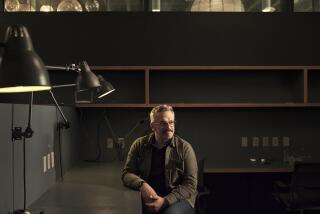Decision to Import Haun Jury a Big Cost-Saver for County
- Share via
It was a novel solution: Import a jury from a neighboring county to decide the guilt or innocence of a woman accused in the most high-profile murder case in recent Ventura County history.
But the decision by Superior Court Judge Frederick A. Jones to bring in a Santa Barbara County jury for the Diana Haun trial proved to be more than just innovative.
It was cheap.
Busing 18 jurors from Santa Barbara to Ventura for 38 court days cost the county about $18,500--significantly less than had the case been moved to another jurisdiction, court officials said last week.
Consider the $250,000 in court-related costs that Los Angeles County spent when the Rodney King beating case against four Los Angeles police officers was moved to Simi Valley five years ago.
Or the $687,000 that Sonoma County spent last year to move the trial of Polly Klaas’ killer, Richard Allen Davis, to Santa Clara County.
“There are a lot more costs involved when you move a case,” said Vince Ordonez, assistant executive officer for the Ventura County Superior and Municipal courts.
If the Haun trial had been relocated to another site, Ordonez said, the county would have had to pay for security, lodging and transportation for the judge, lawyers and court staff members.
But by busing in jurors from Santa Barbara each morning and sending them home again in the evening, Ordonez said the judge may have saved county taxpayers tens of thousands of dollars.
“A change of venue could have been any place,” he said. “It certainly would have been more [costly].”
And the jurors had no complaints about the bus ride down the coast each morning, reading or watching dolphins in the Pacific.
Heavy pretrial publicity surrounding the kidnapping and slaying of Ventura homemaker Sherri Dally prompted defense attorneys to seek a venue change earlier this year.
Lawyers argued that potential jurors in Ventura County had become so tainted by media coverage it would be impossible for Haun and co-defendant Michael Dally to receive a fair trial.
But instead of sending the trial elsewhere, Jones used a rarely applied legal statute that states judges should consider bringing in an outside jury before transferring a case.
In an agreement with prosecutors and defense lawyers, Jones decided to bus Haun’s jury 30 miles south each day from neighboring Santa Barbara County, where media coverage had been minimal.
Lawyers agreed bringing in an outside group would reduce the burden on witnesses while still guarding the defendant’s fair-trial rights.
The trial spanned three months, including six weeks of testimony before the jury found Haun guilty of killing Sherri Dally. After a short break, the jury returned for another week’s worth of testimony to decide her punishment: life in prison without parole.
The same procedure--importing a jury--is expected to be followed for Michael Dally’s upcoming trial, which Jones decided should be held separate from Haun’s.
Although the practice is allowed by statute, legal experts said importing a jury is rarely done. Officials with the Administrative Office of the Courts in San Francisco could not cite a single case in which a jury had been bused in from another area, but added they did not believe such a move was unprecedented.
“I don’t know of any,” said Laurie Levenson, a dean at Loyola Law School. “Frankly, there are not that many changes of venue granted per year in California.”
If it were simply a matter of money, Levenson said more judges would probably decide to import juries because it’s easier to move 12 or 18 people than relocating an entire trial.
But in many high-profile cases in which venue change motions are sought, pretrial publicity saturates an entire region, making it difficult to find jurors in any setting.
And, Levenson said, “you still have that nagging issue of: Are you getting representation by the community that was affected by the crime? I think, logistically, it is not so easy.”
When jury selection in the Haun case began last summer, Jones warned prospective jurors of the awesome burden that awaited them if chosen to serve on the panel.
“We all know this is going to be an inconvenience for you,” Jones said. “What I propose for you is to make that travel as easy as possible.”
Jurors who served on the case said the judge kept his word.
“He did everything he could to accommodate us,” said juror James Brock, 37, a systems analyst for the Santa Barbara Municipal Court.
Jones reserved a jury assembly room--complete with a refrigerator--so the 12 jurors and six alternates could leave their belongings and lunches for the day.
When they complained about the small van shuttling them back and forth on the first day of the trial, the judge immediately made arrangements for a larger 40-passenger bus, jurors said.
“He just bent over backward,” said juror Bert Walker, 74, a tile store owner.
The one aspect of jury service that had the potential to be the most burdensome--busing from Santa Barbara to Ventura each day--turned out to be a positive experience that many jurors said they enjoyed.
“I was really starting to enjoy that trip,” said Walker, saying he enjoyed watching dolphins from the bus window. “It was really quite nice.”
The bus trip--which cost the county $292.50 a day--enabled jurors to talk, read and unwind from the day’s testimony, jurors said. And it saved them from having to fight traffic.
“We didn’t have to drive ourselves,” said jury foreman Noel Langle, 44, a county planner from Goleta. “We just showed up, parked, hopped on a bus and [were driven] down there.”
It remains to be seen whether the jury for Michael Dally’s trial will have the same reaction. The transportation costs are expected to be the same, Ordonez said. It just depends on how many days the group must be bused to the Ventura courthouse.
Dally’s trial on charges of murder, kidnapping and conspiracy is scheduled to begin Nov. 24. Defense attorneys have expressed concern in court on whether Dally can receive a fair trial from a Santa Barbara County jury, based on recent media coverage of Haun’s trial.
But according to jurors on that case, several of whom saved copies of newspapers to read after the trial ended, publicity in Santa Barbara County has been minimal. Several said they had no doubts Dally could receive a fair trial from Santa Barbara County jurors.
“They haven’t publicized the trial much at all,” Walker said.
“We all hear about these things but we don’t make up our minds until we hear all of the evidence,” he added. “They could pick somebody from here or Glendale or Oxnard and get a fair jury.”
More to Read
Sign up for Essential California
The most important California stories and recommendations in your inbox every morning.
You may occasionally receive promotional content from the Los Angeles Times.









